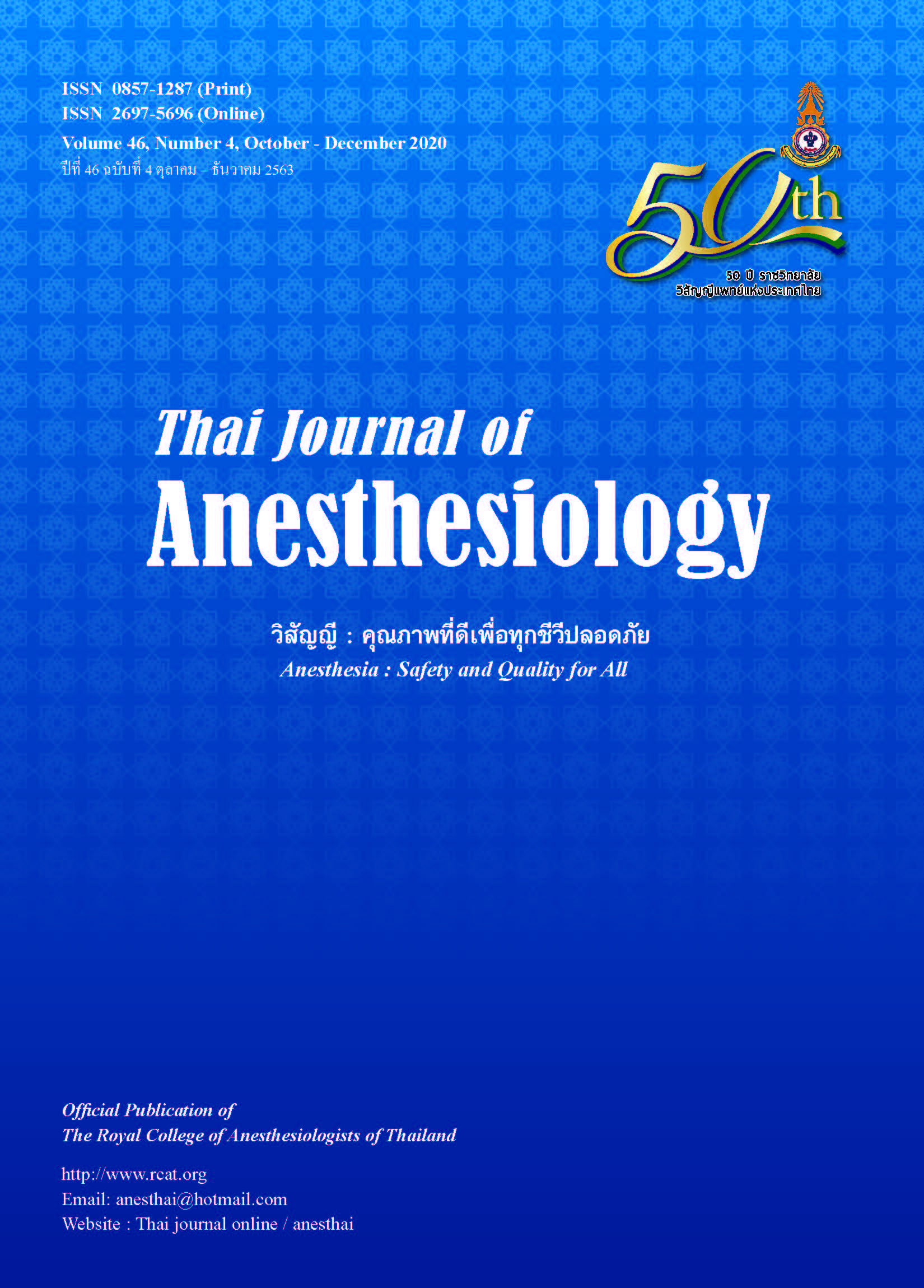Comparison of End Tidal Carbon Dioxide Level along the Time of Surgery between Pressure Support Ventilation versus Spontaneous Ventilation in General Anesthesia under Laryngeal Mask Airway in Breast Surgery: A Randomized Controlled Trial
Main Article Content
Abstract
Introduction: Laryngeal mask airway (LMA) can be ventilated with various modes. The most popular mode is spontaneous ventilation (SV). Nonetheless, pressure support ventilation (PSV) showed lower level of end tidal carbon dioxide in the previous studies. Objectives: To compare the level of end tidal carbon dioxide along the time of surgery between PSV and SV group. Methods: We enrolled 38 patients who scheduled for breast surgery underwent general anesthesia with LMA-Proseal™ in this randomized controlled trial. The patients were allocated in two groups, group P for PSV and group S for SV. Then, respiratory and hemodynamic parameters were recorded. Results: End tidal carbon dioxide along duration of surgery was not different in both groups. The peak inspiratory pressure (PIP) minus positive end expiratory pressure (PEEP) in group P was lower than group S (13.32±3.51 versus 18.89±6.33 cmH2 O; P = 0.002). Conclusion: Pressure support ventilation during general anesthesia under LMA-ProSeal™ in breast surgery appears to be as effective as spontaneous ventilation in gas exchange.
Article Details
References
laryngeal mask airway and endotracheal intubation for
anaesthesia in adult patients undergoing NUSS procedure.
J Thorac Dis 2018;10:3216-24.
2. Song Z, Tan J, Fang J, Bian Q, Gu L. Comparison of laryngeal
mask airway and endotracheal intubation in gynecological
cancer operation. Oncol Lett 2019;17:2344-50.
3. Devitt JH, Wenstone R, Noel AG, O’Donnell MP. The laryngeal
mask airway and positive-pressure ventilation. Anesthesiology
1994;80:550-5.
4. Riem N, Boet S, Tritsch L, Bould D. LMA with positive
pressure ventilation is safe! Korean J Anesthesiol
2011;61:88-9.
5. Zoremba M, Kalmus G, Dette F, Kuhn C, Wulf H. Effect of
intra-operative pressure support vs pressure controlled
ventilation on oxygenation and lung function in moderately
obese adults. Anaesthesia 2010;65:124-9.
6. Feldman JM. Pressure-support ventilation in the operating
room. Anesthesiology 2007;107:670.
7. Keller C, Sparr HJ, Luger TJ, Brimacombe J. Patient
outcomes with positive pressure versus spontaneous
ventilation in non-paralysed adults with the laryngeal mask.
Can J Anaesth 1998;45:564-7.
8. Brimacombe J, Keller C, Hormann C. Pressure support
ventilation versus continuous positive airway pressure with
the laryngeal mask airway: a randomized crossover study of
anesthetized adult patients. Anesthesiology 2000;92:1621-3.
9. von Goedecke A, Brimacombe J, Hormann C, Jeske HC,
Kleinsasser A, Keller C. Pressure support ventilation versus
continuous positive airway pressure ventilation with the
ProSeal laryngeal mask airway: a randomized crossover
study of anesthetized pediatric patients. Anesth Analg
2005;100:357-60.
10. Lim B, Pawar D, Ng O. Pressure support ventilation vs
spontaneous ventilation via ProSeal laryngeal mask airway
in pediatric patients undergoing ambulatory surgery:
a randomized controlled trial. Paediatr Anaesth 2012;22:
360-4.
11. Christie JM, Smith RA. Pressure support ventilation
decreases inspiratory work of breathing during general
anesthesia and spontaneous ventilation. Anesth Analg
1992;75:167-71.
12. Asai T. Editorial II: Who is at increased risk of pulmonary
aspiration? Br J Anaesth 2004;93:497-500.
13. Lopez-Gil M, Brimacombe J, Garcia G. A randomized
non-crossover study comparing the ProSeal and Classic
laryngeal mask airway in anaesthetized children. Br J
Anaesth 2005;95:827-30.
14. Lardner DR, Cox RG, Ewen A, Dickinson D. Comparison of
laryngeal mask airway (LMA)- Proseal™ and the LMAClassic™ in ventilated children receiving neuromuscular
blockade. Can J Anaesth 2008;55:29-35.
15. Cook TM, Lee G, Nolan JP. The ProSeal laryngeal mask
airway: a review of the literature. Can J Anaesth 2005;52:
739-60.
16. Costa EL, Slutsky AS, Amato MB. Driving pressure as a key
ventilation variable. N Engl J Med 2015;372:2072.
17. Amato MB, Meade MO, Slutsky AS, et al. Driving pressure
and survival in the acute respiratory distress syndrome. N
Engl J Med 2015;372:747-55.
18. Brain AI, Verghese C, Strube PJ. The LMA ‘ProSeal’--a laryngeal mask with an oesophageal vent. Br J Anaesth
2000;84:650-4.
19. Goldmann K, Jakob C. A randomized crossover comparison
of the size 2 1/2 laryngeal mask airway ProSeal versus
laryngeal mask airway-Classic in pediatric patients. Anesth
Analg 2005;100:1605-10.


